Effect of High Concentrations of Wood Ash on Soil Properties and Development of Young Norway Spruce (Picea abies (L.) Karst) and Scots Pine (Pinus sylvestris L.)
Abstract
1. Introduction
2. Materials and Methods
2.1. Study Site
2.2. Data Analysis
3. Results
3.1. Fertilization Effect on Soil Chemical Composition one Year Afterwards
3.2. Ten Years after Fertilization
3.3. Growth of Fertilized Trees
3.4. Dead Standing Tree Parameters
4. Discussion
5. Conclusions
Supplementary Materials
Author Contributions
Funding
Acknowledgments
Conflicts of Interest
References
- Møller, I. Calculation of biomass and nutrient removal for different harvesting intensities. N. Z. J. For. Sci. 2000, 30, 29–45. [Google Scholar]
- Blanco, J.A.; Zavala, M.A.; Imbert, J.B.; Castillo, F.J. Sustainability of forest management practices: Evaluation through a simulation model of nutrient cycling. For. Ecol. Manag. 2005, 213, 209–228. [Google Scholar] [CrossRef]
- Egnell, G. Is the productivity decline in Norway spruce following whole-tree harvesting in the final felling in boreal Sweden permanent or temporary? For. Ecol. Manag. 2011, 261, 148–153. [Google Scholar] [CrossRef]
- Helmisaari, H.S.; Vanguelova, E. (Eds.) Approaches to soil sustainability in guidelines for forest biomass harvesting and production in forests and plantations. In Proceedings of the Workshop W6.1 Forest bioenergy and soil sustainability at EUROSOIL Congress, Bari, Italy, 2–6 July 2012; p. 72. [Google Scholar]
- Ingerslev, M.; Hansen, M.; Pedersen, L.B.; Skov, S. Effects of wood chip ash fertilization on soil chemistry in a Norway spruce plantation on a nutrient-poor soil. For. Ecol. Manag. 2014, 334, 10–17. [Google Scholar] [CrossRef]
- Saarsalmi, A.; Mälkönen, E. Forest Fertilization Research in Finland: A Literature Review. Scand. J. For. Res. 2001, 16, 514–535. [Google Scholar] [CrossRef]
- Ingerslev, M.; Skov, S.; Sevel, L.; Pedersen, L.B. Element budgets of forest biomass combustion and ash fertilization—A Danish case-study. Biomass Bioenergy 2011, 35, 2697–2704. [Google Scholar] [CrossRef]
- Stupak, I.; Raulund-Rasmussen, K.; Asikainen, A.; Röser, D.; Lunnan, A.; Karltun, E.; Jonsell, M.; Schrøder, M.; Ozolincius, R.; Mandre, M.; et al. Sustainable use of forest biomass for energy. In Proceedings of the Regular Recycling of Wood Ash to Prevent Waste Production RecAsh–A Life –environment demonstration project RECASH–INTERNATIONAL SEMINAR, Prague, Czech Republic, 8–10 November 2005; pp. 63–66. [Google Scholar]
- Röser, D.; Asikainen, A.; Raulund-Rasmussen, K.; Stupak, I. Sustainable Use of Forest Biomass for Energy: A Synthesis with Focus on the Baltic and Nordic Region; Springer: Dordrecht, The Netherlands, 2008; p. 261. [Google Scholar] [CrossRef]
- Bruvelis, A. Koksnes Pelnu Ietekme uz Skujkoku Ietvarstādu Morfoloģiskajiem Rādītājiem Kūdras Augsnē (in Latvian-Impact of Wood Ash on Morphological Parameters of Coniferous Seedlings on Peat Soil). Master’s Thesis, Environmental Science Department, Faculty of Geography and Earth sciences, University of Latvia, Riga, Latvia, 2005; p. 67. [Google Scholar]
- Gaitnieks, T.; Brūvelis, A.; Indriksons, A.; Zālītis, P. Influence of wood ash on morphological parameters and mycorrhizing of Scots pine containerized seedlings. Metsanduslikud Uurim. For. Stud. 2005, 42, 74–78. [Google Scholar]
- Lazdiņa, D.; Bebre, I.; Dūmiņš, K.; Skranda, I.; Lazdins, A.; Jansons, J.; Celma, S. Wood ash–Green energy production side product as fertilizer for vigorous forest plantations. Agron. Res. 2017, 15, 468–477. [Google Scholar]
- Petaja, G.; Okmanis, M.; Makovskis, K.; Lazdiņa, D.; Lazdiņš, A. Forest fertilization: Economic effect and impact on GHG emissions in Latvia. Balt. For. 2018, 24, 9–16. [Google Scholar]
- Eriksson, H.M. Short-term effects of granulated wood ash on forest soil chemistry in SW and NE Sweden. Scand. J. For. Res. 1998, 2, 43–55. [Google Scholar]
- Eriksson, H.; Nilsson, T.; Nordin, A. Early effects of lime and hardened and non-hardened ashes on pH and electrical conductivity of the forest floor, and relations to some ash and lime qualities. Scand. J. For. Res. 1998, 2, 56–66. [Google Scholar]
- Arvidsson, H.; Vestin, T.; Lundkvist, H. Effects of crushed wood ash application on ground vegetation in young Norway spruce stands. For. Ecol. Manag. 2002, 161, 75–87. [Google Scholar] [CrossRef]
- Arvidsson, H.; Lundkvist, H. Effects if crushed wood ash on soil chemistry in young Norway spruce stands. For. Ecol. Manag. 2003, 176, 121–132. [Google Scholar] [CrossRef]
- Jacobsen, S.; Högbom, L.; Ring, E. Effects of wood ash dose and formulation on soil chemistry at two coniferous sites. Water Air Soil Pollut. 2004, 158, 113–125. [Google Scholar] [CrossRef]
- Moilanen, M.; Silfverberg, K.; Hakka, H.; Issakainen, J. Wood ash as a fertilizer on drained mires–growth and foliar nutrients of Scots pine. Can. J. For. Res. 2005, 35, 2734–2742. [Google Scholar] [CrossRef]
- Pitman, R.M. Wood ash use in forestry—A review of the environmental impacts. Forestry 2006, 79, 563–588. [Google Scholar] [CrossRef]
- Ring, E.; Jacobsen, S.; Nohrstedt, H.O. Soil-solution chemistry in a coniferous stand after adding wood ash and nitrogen. Can. J. For. Res. 2006, 36, 153–163. [Google Scholar] [CrossRef]
- Saarsalmi, A.; Mälkönen, E.; Kukkola, M. Effect of wood ash fertilization on soil chemical properties and stand nutrient status and growth of some coniferous stands in Finland. Scand. J. For. Res. 2004, 19, 217–233. [Google Scholar] [CrossRef]
- Saarsalmi, A.; Smolander, A.; Moilanen, M.; Kukkola, M. Wood ash in boreal, low-productive pine stands on upland and peatland sites: Long-term effects on stand growth and soil properties. For. Ecol. Manag. 2014, 327, 86–95. [Google Scholar] [CrossRef]
- Hedwalla, P.O.; Gongb, P.; Ingerslevd, M.; Bergh, J. Fertilization in northern forests–biological, economic and environmental constraints and possibilities. Scand. J. For. Res. 2014, 29, 301–311. [Google Scholar] [CrossRef]
- Pettersson, F. Predictive Functions for Calculating the Total Response in Growth to Nitrogen Fertilization, Duration and Distribution over Time; Report No. 4; Forestry Research Institute of Sweden: Uppasala, Sweden, 1994; p. 34. ISSN 1103-6648. [Google Scholar]
- Pettersson, F.; Högbom, L. Long-term Growth Effects Following Forest Nitrogen Fertilization in Pinus sylvestris and Picea abies Stands in Sweden. Scand. J. For. Res. 2004, 19, 339–347. [Google Scholar] [CrossRef]
- Rosenberg, O.; Persson, T.; Högbom, L.; Jacobson, S. Effects of wood-ash application on potential carbon and nitrogen mineralization at two forest sites with different tree species, climate and N status. For. Ecol. Manag. 2010, 260, 511–518. [Google Scholar] [CrossRef]
- Klavina, D.; Pennanen, T.; Gaitnieks, T.; Velmala, S.; Lazdins, A.; Lazdina, D.; Menkis, A. The ectomycorrhizal community of conifer stands on peat soils 12 years after fertilization with wood ash. Mycorrhiza 2016, 26, 153–160. [Google Scholar] [CrossRef]
- Emilsson, S. International Handbook: From Extraction of Forest Fuels to Ash Recycling; Swedish Forest Agency: Jönköping, Sweden, 2006; pp. 1–48.
- Bušs, K. Forest Classification in Latvia; Science and Manufacturing Congregation “Silava”: Lrztipi, Rīga, 1976; 24p. (in Latvian) [Google Scholar]
- Kļaviņa, D.; Muižnieks, I.; Gaitnieks, T.; Nikolajeva, V.; Lazdiņa, D.; Lazdiņš, A.; Bārdule, A.; Menkis, A. Fungal Communities in Roots of Scots Pine and Norway Spruce Saplings Grown for 10 Years on Peat Soils Fertilized with Wood Ash. Balt. For. 2016, 22, 25–33. [Google Scholar]
- Campbell, A.G. Recycling and Disposing of Wood Ash. Tappi, J. 1990, 9, 141–145. [Google Scholar]
- Ozolinčius, R.; Armolaitis, K.; Mikšys, V.; Varnagiryte-Kašinskiene, I. Komessuojamojo Trešimo Miško Kuro Pelenais Rekomendacijos (in Lithuanian Recommendations for Compensating Wood Ash Fertilization); Ministry of Environment of the Republic of Lithuania/Institute of Forestry of Lithuanian Research Centre for Agriculture and Forestry: Girionus, Lithuania, 2011; p. 17.
- Nilsen, P.; Abrahamsen, G. Scots pine and Norway spruce stands responses to annual N, P and Mg fertilization. For. Ecol. Manag. 2003, 17, 221–232. [Google Scholar] [CrossRef]
- Moilanen, M.; Silfverberg, K.; Hokkanen, T.J. Effects of wood-ash on the growth, vegetation and substrate quality of a drained mire: A case study. For. Ecol. Manag. 2002, 171, 321–338. [Google Scholar] [CrossRef]
- Jansons, Ā.; Matisons, R.; Krišāns, O.; Džeriņa, B.; Zeps, M. Effect of initial fertilization on 34 year increment and wood properties of Norway spruce in Latvia. Silva. Fenn. 2016, 50, 1346. [Google Scholar] [CrossRef]
- Hytönen, J. Pellets made of wood ash and other wastes as nutrient sources for silver birch seedlings [Puutuhkasta ja muista jäteaineista valmistetut pelletit rauduskoivun taimien ravinnelähteenä]. Suo 1998, 49, 49–63. [Google Scholar]
- Kikamägi, K.; Ots, K.; Kuznetsova, T.; Pototski, A. The growth and nutrients status of conifers on ash-treated cutaway peatland. Trees 2014, 28, 53–64. [Google Scholar] [CrossRef]
- Pärn, H. Effect of wood ash application on radial and height growth of young Scots pines (Pinus sylvestris L.). Metsanduslikud Uurim. For. Stud. 2005, 42, 48–55. [Google Scholar]
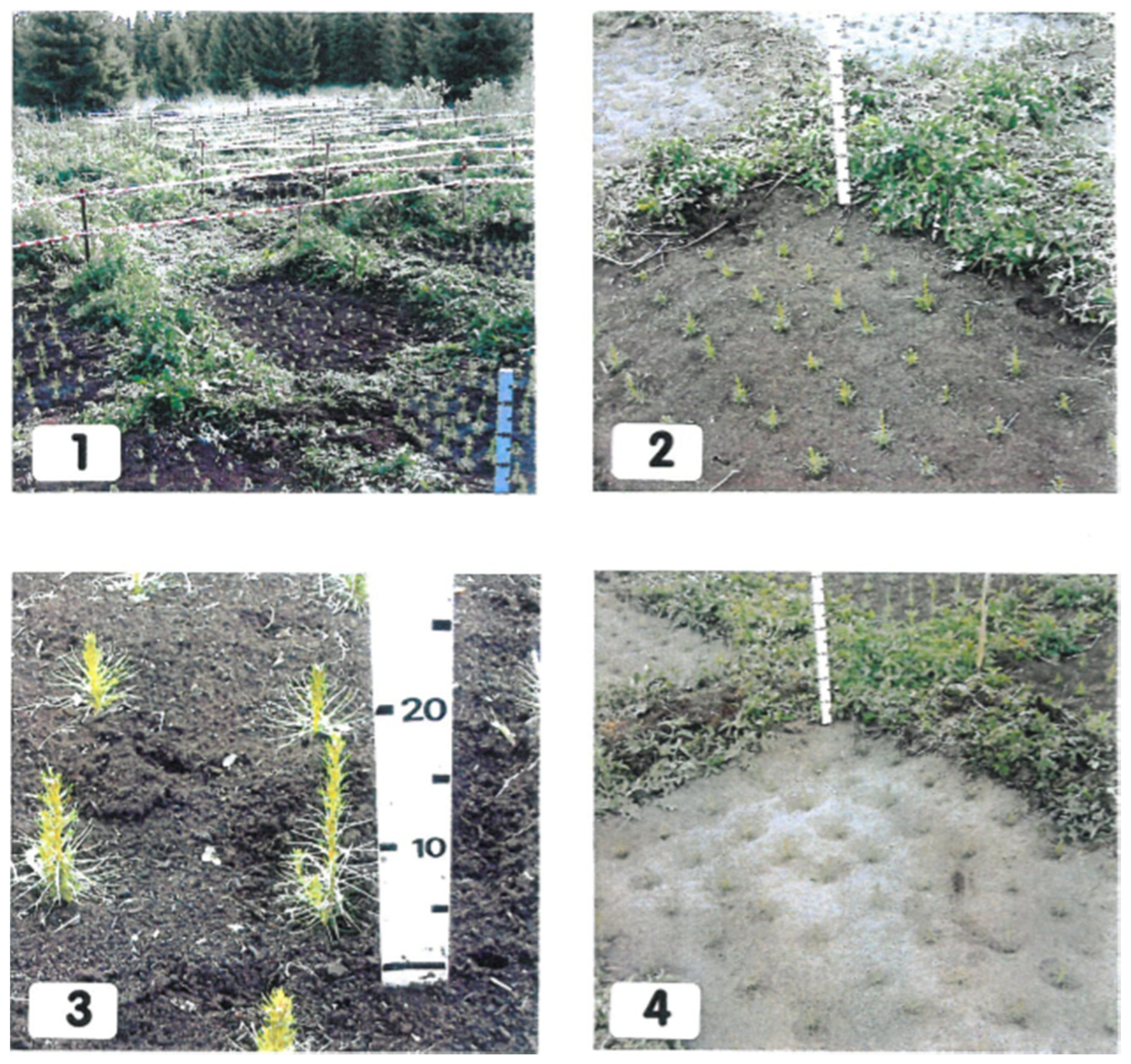
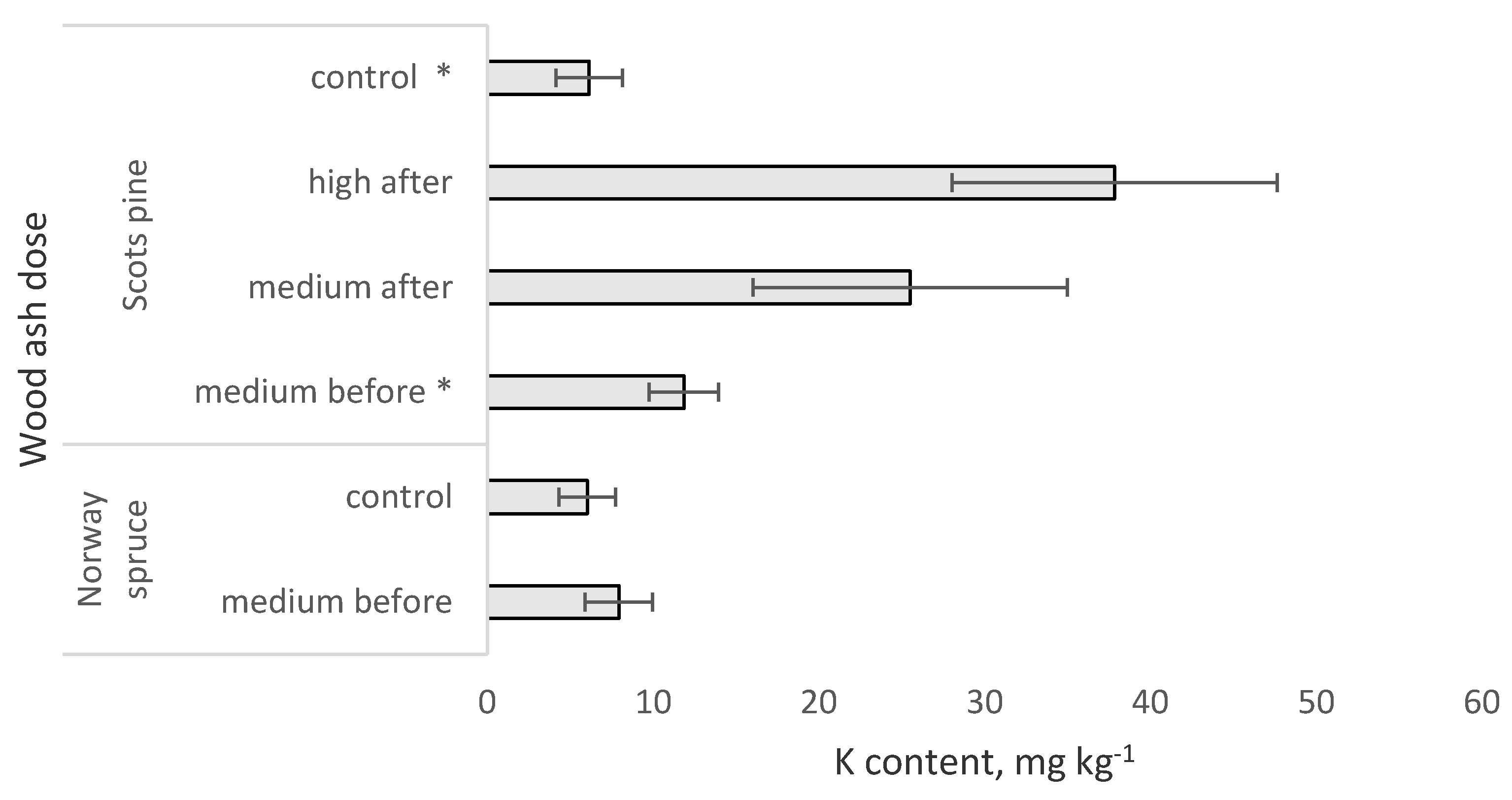

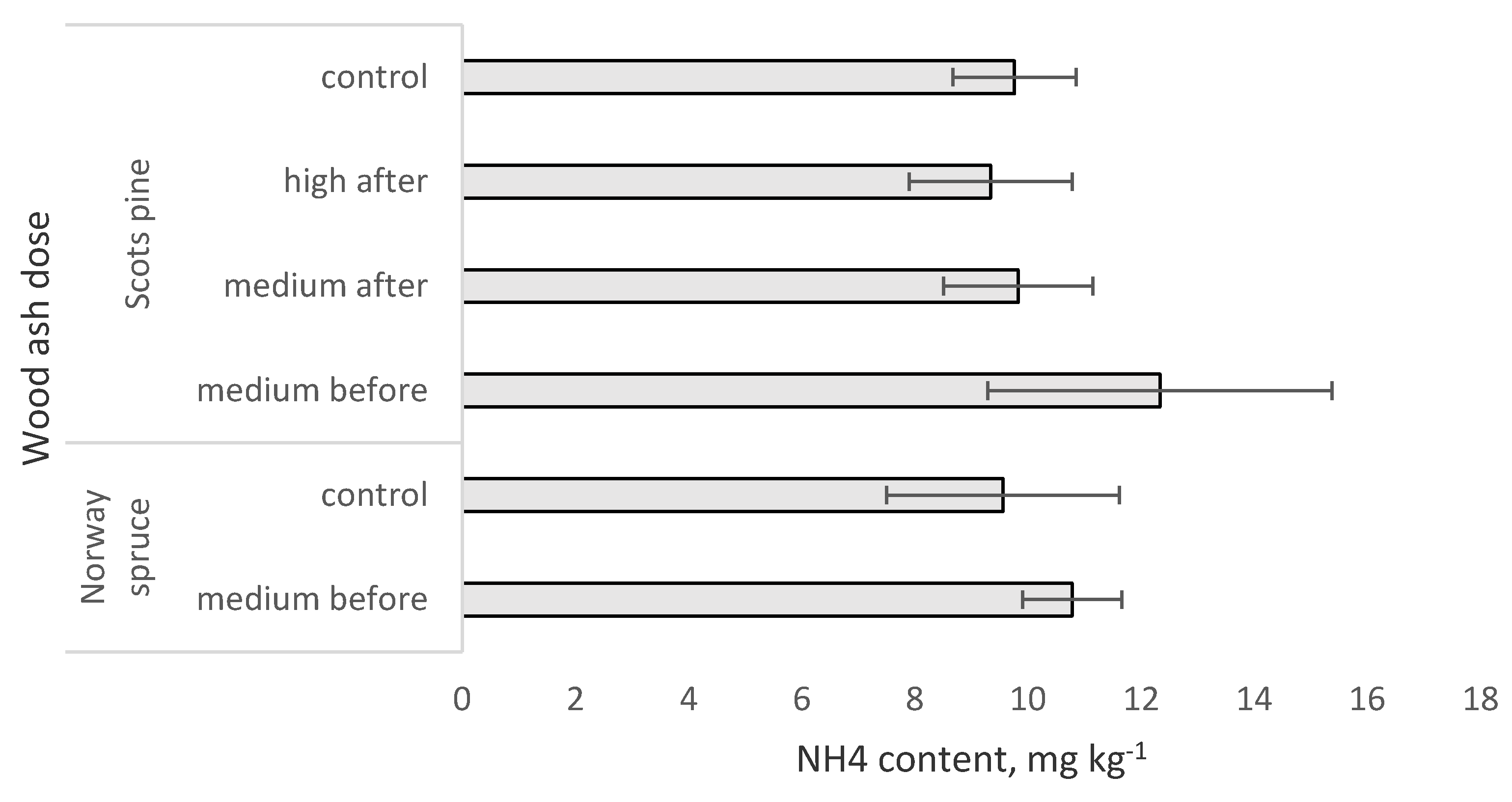
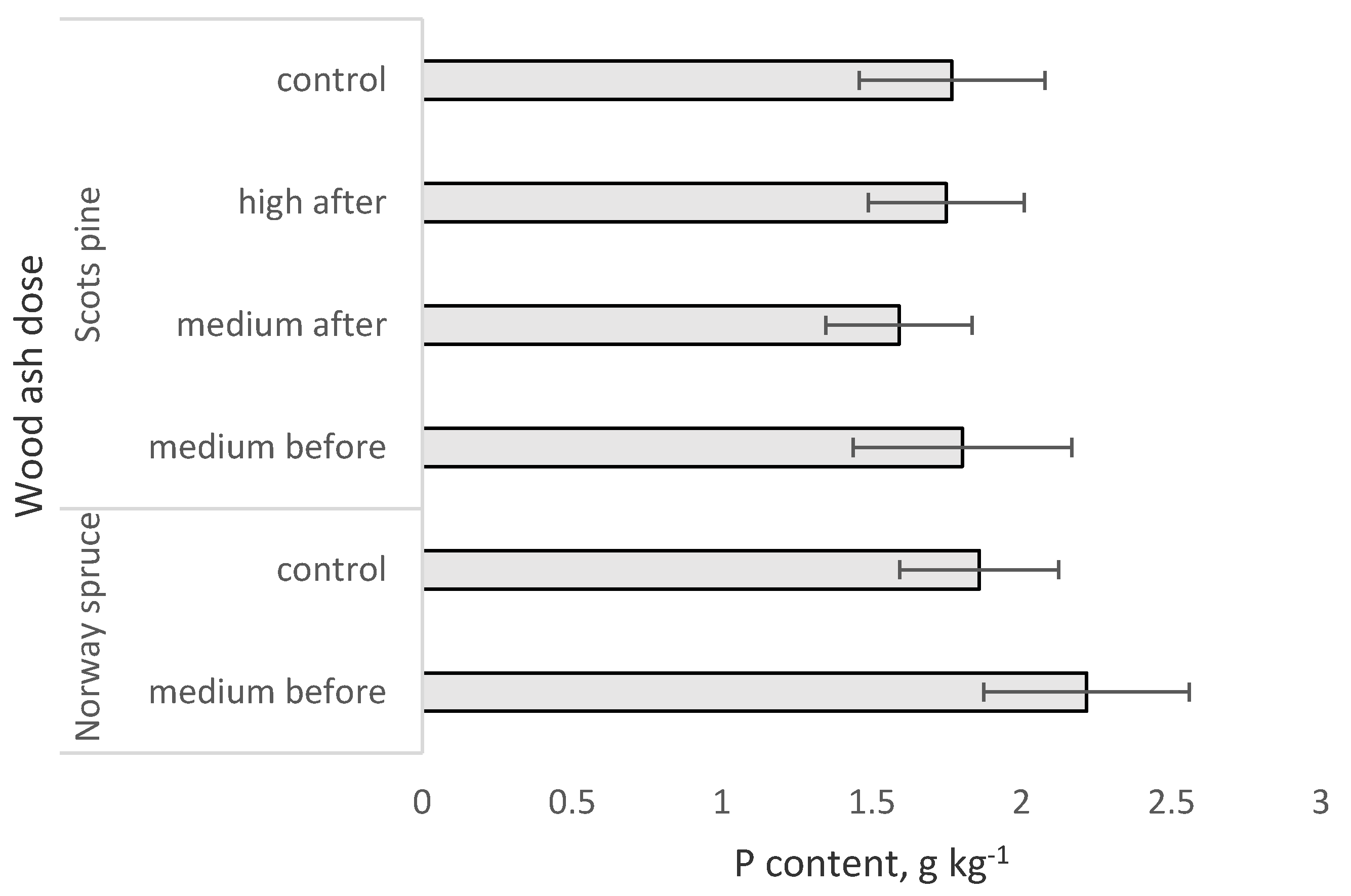
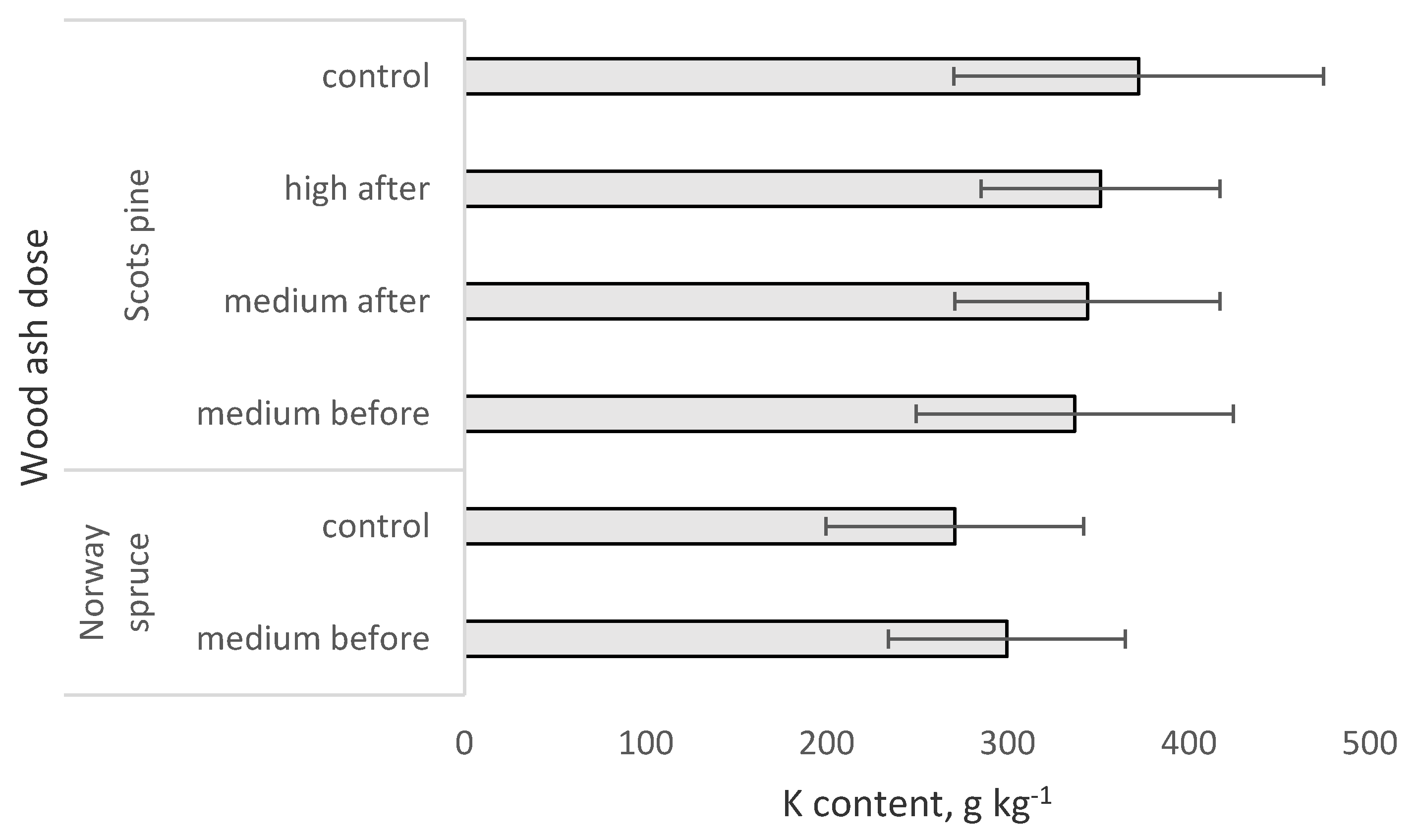

| Variant | Tree Species | Seedling Height, cm | Aboveground Biomass, g | Root Mass, g | Root Mass % From Plant Mass |
|---|---|---|---|---|---|
| Control | Scots pine | 15.2 ± 0.3 | 3.11 ± 0.13 | 1.19 ± 0.05 | 27.7 ± 0.6 |
| Medium before | Scots pine | 15.8 ± 0.4 * | 3.71 ± 0.17 * | 1.43 ± 0.08 * | 28.0 ± 0.8 |
| Medium after | Scots pine | 14.9 ± 0.3 | 2.90 ± 0.11 | 1.26 ± 0.06 | 30.2 ± 0.7 |
| High after | Scots pine | 14.9 ± 0.3 | 2.83 ± 0.12 | 1.16 ± 0.06 | 29.7 ± 0.7 |
| Medium before | Norway spruce | - | 0.60 ± 0.04 * | 0.26 ± 0.02 * | 30.5 ± 0.9 * |
| Control | Norway spruce | - | 0.53 ± 0.03 | 0.23 ± 0.02 | 29.6 ± 0.7 |
| Elements | Wood Ash Chemical Content, % [10] | Range of Wood Ash Chemical Content in Other Studies, % [32,33] |
|---|---|---|
| Phosphorus (P) | 0.92 | 0.3–1.4 |
| Potassium (K) | 2.30 | 1.4–4.2 |
| Calcium (Ca) | 22.0 | 7.4–33.1 |
| Magnesium (Mg) | 1.50 | 0.7–2.2 |
| Silicon (S) | 0.38 | 0.4–0.7 |
| Iron (Fe) | 0.39 | 0.3–2.1 |
| Manganese (Mn) | 0.67 | 0.3–1.3 |
| Zinc (Zn) | 0.11 | 0.0004–0.0820 |
| Copper (Cu) | 0.0054 | 0.0052–0.0289 |
| Molybdenum (Mo) | 0.000125 | |
| Boron (B) | 0.0158 | 0.0022–0.0225 |
| Sodium (Na) | 0.093 |
Publisher’s Note: MDPI stays neutral with regard to jurisdictional claims in published maps and institutional affiliations. |
© 2020 by the authors. Licensee MDPI, Basel, Switzerland. This article is an open access article distributed under the terms and conditions of the Creative Commons Attribution (CC BY) license (http://creativecommons.org/licenses/by/4.0/).
Share and Cite
Jansone, B.; Samariks, V.; Okmanis, M.; Kļaviņa, D.; Lazdiņa, D. Effect of High Concentrations of Wood Ash on Soil Properties and Development of Young Norway Spruce (Picea abies (L.) Karst) and Scots Pine (Pinus sylvestris L.). Sustainability 2020, 12, 9479. https://doi.org/10.3390/su12229479
Jansone B, Samariks V, Okmanis M, Kļaviņa D, Lazdiņa D. Effect of High Concentrations of Wood Ash on Soil Properties and Development of Young Norway Spruce (Picea abies (L.) Karst) and Scots Pine (Pinus sylvestris L.). Sustainability. 2020; 12(22):9479. https://doi.org/10.3390/su12229479
Chicago/Turabian StyleJansone, Baiba, Valters Samariks, Modris Okmanis, Dārta Kļaviņa, and Dagnija Lazdiņa. 2020. "Effect of High Concentrations of Wood Ash on Soil Properties and Development of Young Norway Spruce (Picea abies (L.) Karst) and Scots Pine (Pinus sylvestris L.)" Sustainability 12, no. 22: 9479. https://doi.org/10.3390/su12229479
APA StyleJansone, B., Samariks, V., Okmanis, M., Kļaviņa, D., & Lazdiņa, D. (2020). Effect of High Concentrations of Wood Ash on Soil Properties and Development of Young Norway Spruce (Picea abies (L.) Karst) and Scots Pine (Pinus sylvestris L.). Sustainability, 12(22), 9479. https://doi.org/10.3390/su12229479






